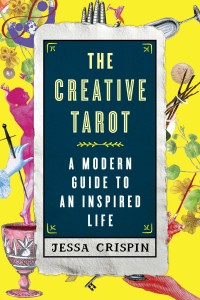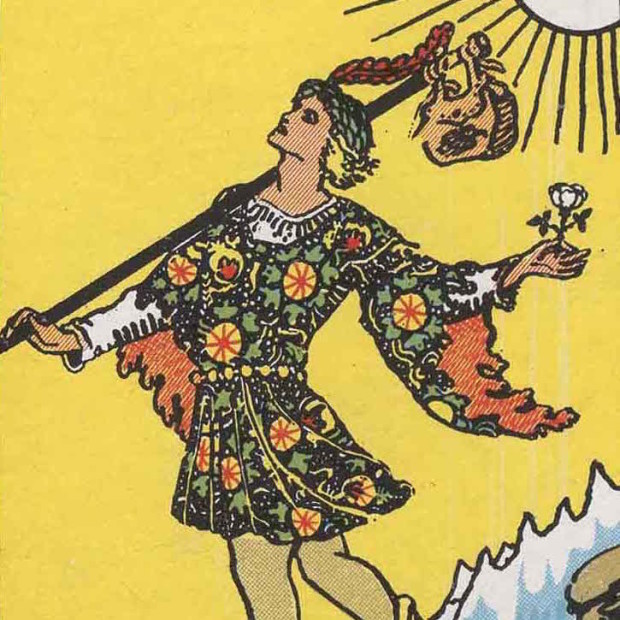 I am new to the tarot. Over the past few years, some of my friends and acquaintances have started to study / read the tarot, and my initial skepticism turned into curiosity as their approach showed me that it doesn’t have to be about “predicting the future.”
I am new to the tarot. Over the past few years, some of my friends and acquaintances have started to study / read the tarot, and my initial skepticism turned into curiosity as their approach showed me that it doesn’t have to be about “predicting the future.”
You can take the tarot as seriously (or not) as you’d like. It can be a vehicle for storytelling. It can be fun. If you don’t “believe” in it, that’s fine. If you do believe in it, that’s fine too. In The Creative Tarot: A Modern Guide to an Inspired Life, Jessa Crispin provides a well rounded guide that can serve as both an introduction to tarot for beginners and skeptics, or a fresh approach and interpretation for tarot veterans.
As Crispin puts it:
“It is not necessarily about telling the future. It is about retelling the present.”
“We give things meaning by paying attention to them, and so moving your attention from one thing to another can absolutely change your future. Exactly who or what is doing the work here — whether fate is choosing the card, or your unconscious, or random chance — doesn’t matter as much as the act of seeing, sensing, and paying attention.”
I think the tarot is a fun (and sometimes incredibly useful) way of looking at things in a new light. You can think of it as pulling thought prompts that contain symbols and meanings, and using them as a base for exploring your thoughts and feelings from an angle you might not have thought of on your own.
Crispin begins by walking through an introduction to the tarot: its history, the artists who have created some of the most commonly used decks, and her own history with the tarot and how she began to use it with a creative lens. Why is creativity a good topic for the tarot?
“Nothing kills creativity faster than anxiety: worrying if you’re doing things “right,” worrying that no one else is going to like when you’re doing, panicking about how it’s all going to turn out.
Almost every time, the solution is listening to and honoring your intuitive sense of not what you think you need but what your project needs to come to fruition. Maybe that is the greatest thing the cards can do for us: quiet down our worried thoughts and our expectations for how it’s “supposed” to go and help us get back in touch with our imagination.”
She then walks through each of the cards in the deck. She begins with a short introduction to the imagery and the traditional definition of the card. Then she she layers in the creative approach to each card:
“I’ve taken stories, from biographies, from my clients, from the worlds of film and literature and music, of how artists have dealt with problems in their process. How musicians battled their record companies for the right to record their music their way. Or how a writer overcame losing everything he’d ever written when his wife left their suitcase on a train. Or how a composer dealt with the humiliation of a riot at his opera’s premiere.”
“These stories should also give the reader wider meaning to the cards, to show how they can work in the real world. How people respond to these quandaries can give you ideas on how you might respond to your own. And they help relate the cards more directly to the artistic experience.”
And finally, she lists recommended materials to further explore each card. Movies, books, music, artwork, poems, etc. I love this idea, and I think each reader can begin adding to these lists with examples they’ve encountered that bring a deeper personal meaning to each card. Each card represents an archetype, and once you’re familiar with the cards you can start to identify them everywhere. For example, Auntie Mame is the perfect representation of the Nine of Cups. “The self-contained happiness and pleasure of that card is shown in the world-traveling, party-throwing, joyful, and wise spinster aunt.”
I bought myself a Rider deck (I love Pamela Colman Smith’s artwork), and Jessa Crispin is quick to debunk the idea that your first deck needs to be a gift. (“It is absolutely ok for you to buy your first tarot deck. That is one of those mystical mumbo-jumbo things designed to make beginners feel inadequate and unwelcome. I have a Virgo moon; I have no time for such nonsense.“) You don’t need to have a tarot deck in hand while you read it. There are black & white reproductions of the Rider deck included with each card’s section, and you can always google full color images. But I did enjoy having a deck to refer to as I went through each of the cards in the guide.
Bottom line: if you’re curious about the tarot, this is a wonderful introduction. Creative work doesn’t need to be your full time job either, if you only work on creative projects in your spare time I think you’ll still enjoy learning about the tarot through the lens of creativity. Even if you’re incredibly skeptical about the tarot — if you’re interested in the subject of creativity and the art of creation, you may end up enjoying how this guide approaches the creative process, and how artistic stumbling blocks can be rethought and reshaped to move a project forward.
//
FTC disclosure: I received a review copy of this book from the publisher.

Ah, this makes Tarot seem like such good fun! I kind of want my own deck now…
I’ve been doing a daily card pull, and it’s been so much fun! And The Creative Tarot has been a great introduction.
I have always been curious about tarot but never really explored it. This book sounds worth checking out!
It’s definitely been a wonderful introduction – I highly recommend it if you’re interested! :D
Yay! I just got a review copy of this yesterday and am loving it. I am a big fan of the tarot. I have a collection of different decks and I even have a tattoo of the Strength card from the Rider deck. I had never thought about using the deck for creative pursuits so I’m really enjoying Crispin’s take on it.
I’m so glad you’re loving it too Stefanie! I can definitely see myself starting to build a collection of different decks – the artwork is so beautiful, and the different interpretations are really interesting.
It’s so cool that you have a tattoo of the Strength card – I was thinking that the Rider deck artwork would make incredible tattoos. I could picture getting one myself one day, but I’d have to make the hard choice of which card! :)
I like the Fool a lot too and sometimes I think maybe another tattoo? But I haven’t gotten there yet. One of my favorite decks is cats. It has beautiful fantasy style art. One year for Christmas my sister gave me a blank deck, one I could make my own drawings on but I haven’t managed to be brave enough to do that yet!
Fun! When I think about it, I’ll pull myself a random Tarot card for what my day’s going to be like. Even though I know it’s not real, it can be funny — like on a day when I’ve promised myself a reward of cheese fries if I just get through the day, I’ll pull the Nine of Cups and feel totally smug about my cheese fries reward. :p
We talked about this a little, but I’m super glad Crispin doesn’t take the cards too seriously as a predictive tool. That can get super awkward if you’re the card reader who doesn’t believe in that. I want to check out this book!
Haha I love that you pulled the nine of cups on a cheese fries day! When you remove the predictive element, the tarot is super fun, and I think Jessa Crispin’s approach makes it even more fun. (The suggested materials after each card description are so awesome!)
This is great! You’ve got me convinced to try the book and consider a Tarot deck; I’ve always been curious but was turned off by the “predict the future” angle.
Yay! I hope you enjoy it as much as I did. Her approach is super fun, and I think the creativity aspect is the perfect introduction.